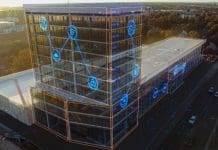Heras UK discuss perimeter protection, focusing on the defence of critical national infrastructure from terrorism, espionage and other hostile activity
Why is perimeter protection a crucial factor to consider?
Today, the UK’s critical national infrastructure (CNI) continues to face real threats from terrorism, espionage and other hostile activity. Threats are not limited to public places, such as crowded events, but the economy is at risk too from attacks to business premises from critical utilities to defence, blue light or other protection organisations.
So, it is increasingly important for CNI organisations to assess their security measures. An effective security strategy should cover an entire organisation’s security requirements from physical assets, through to cyber, data as well as stakeholder awareness, behaviour and culture, including buy-in from the board. The Government’s National Counter Terrorism Security Office (NaCTSO) states that; “businesses can reduce the risk to themselves, their employees and customers by remaining vigilant, being security-minded and having good security measures in place. A small investment in security measures helps to protect businesses against crime and make the work of terrorists and hostile foreign states more difficult.”
Physical perimeter protection
Physical perimeter security is often the first line of defence against a malicious attack and so it’s important for organisations to prioritise protecting their boundaries and facilities from threats and vandalism. In order to have the best possible chance to deter, delay, and detect unwanted intrusion while simultaneously enabling controlled access for authorised parties, organisations need to take an holistic approach to physical perimeter protection. If organisation focuses on just one or two elements for example, access control, it potentially leaves a weak point in the strategy.
So how can CNI organisations best protect their physical premises, perimeters, as well as staff and other assets? Adopting best practice starts by getting back to basics and conducting risk assessments and understanding any operational requirements so that an appropriate security strategy can be developed and safeguards put in place. To achieve complete security protection for physical assets, it is necessary to implement high security systems that have been designed to offer high deterrence and increase the amount of time and effort that is required to attack and get through, over or under them.
Layers of security
Organisations should consider building security in layers. According to Heras, experts in perimeter protection, there are the three main building blocks: building a barrier, controlling access points, and monitoring systems to detect or prevent someone or something bypassing. Firstly, demarcation defines the boundary of a location where a protective barrier or fence should be installed. Once this has been mapped, the boundary requires secure and controlled entry points for both vehicles and pedestrians. Reliable automatic intruder detection is then needed to identify unauthorised personnel crossing a perimeter. The detection technology can integrate with an organisation’s overall security management system to ensure control room staff are notified in real time of any potential intruder.
Cyber attack
Enhanced cyber technologies can offer an additional layer of protection for physical security. It is becoming increasingly common for attackers to threaten both physical and cyber, for example by creating false alarms that affect security perimeter systems as a means of a diversion. There are some simple techniques to stop basic intrusions such as firewalls and decent password protection, but todays hackers are becoming more adept at breaking and entering. Instead, Cyber Assurance for Physical Security Systems (CAPSS) look at the risks to the communication and electronic equipment within perimeter security systems to ensure they are secure. It helps prevent detection control equipment from being compromised so that false alarms or bogus information cannot be triggered by an attacker. It also can prevent cameras from being compromised, which may otherwise allow attackers to alter video images displayed on screens in the control room.
How Heras can help
Some perimeter protection suppliers, like Heras, also offer free consultancy services, which can be valuable in assessing what measures are appropriate and defining the best and most cost effective solution to meet various security and safety requirements of individual organisations. This could be a combination of the three main layers (demarcation, entrance control and perimeter intruder detection systems) along with other technologies and products to increase effectiveness. Recently rebranded Heras now designs, manufactures, supplies, installs and services high security perimeter protection solutions across the UK, and internationally via export, for business, community and industry sectors. With over 65 years operating in the high security sector, the company offers a complete and wholly owned, end to end solution for all physical assets, helping to protect what customers value most.
Threats to the UK critical national infrastructure are very real and organisations should be considering what the appropriate security measures are for their own individual needs. As part of a holistic security strategy, protecting physical assets is an important way to reduce the risk of attack. Above all, protecting property, assets and data is about limiting the potential of disruption to business continuity and reducing risks for people. Lives and livelihoods depend on effective perimeter protection and safety and security cannot be left to chance.
For more information, please visit www.heras.co.uk. Please get in touch by calling +44 161 655 1020 or emailing info@heras.co.uk.













![[VIDEO]With cable theft on the rise, how can you protect your construction site? Copper wire rod non-ferrous metals, product metal industry, representing construction cable theft](https://www.pbctoday.co.uk/news/wp-content/uploads/2024/10/iStock-2167549051-218x150.jpg)